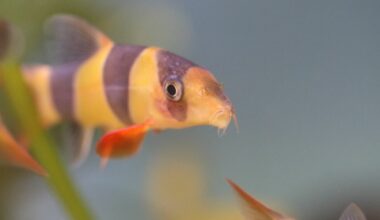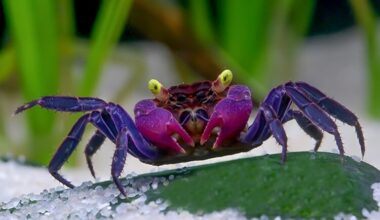Adding a beautiful fish like the Marine Betta to your saltwater aquarium might be a great idea as long as you follow the tips shared in this guide such as tank size, diet and proper mates. They are not terribly difficult to care for so we are confident to say, they are strong and pretty 🙂

Table of Contents
Species Summary
The Marine Betta or Calloplesiops altivelis (scientific name), also known as Comet due to its flowing fins (similar to the Comet Goldfish) and its night pattern, is a tropical longfin fish native to the waters of the Indian and Pacific Oceans, ranging from East Africa to the central-Pacific south of Hawaii. They span as far north as Japan and reach south to the Great Barrier Reef. Bettas live between 10 and 150 feet below the surface, sticking to pinnacle and lagoon patch reefs that provide ample hiding spots.
Their gorgeous appearance undercuts their rugged durability. Bettas are relatively slow-moving nocturnal predators who lurk reef bottoms. They herd their prey, attacking from the side. This tactic involves cornering the fish against coral or rock. The Comet then extends its fins to corral the fish, often leading to the meal swimming right into the Betta’s clutches.
Author Note: Marine Bettas are scaled fish who are relatively shy and non-aggressive. When they are not hunting, they spend their time hiding among rocks and coral. They compensate for their lack of aggression with a unique natural adaptation.
Marine Bettas have a white speckled body and a large dot near their tail fin resembling an eye. When the fish dives head first into a hole or rock opening, the exposed rear portion of its body looks like the intimidating Moray Eel. This deception helps them survive in the wild and adds a dazzling flourish to your tank.
Appearance
Marine Bettas are a dark brownish-black color and are covered in white spots. Their pattern is so consistent that locating their eye is difficult because the iris is white, complementing their natural camouflage. However, the eyes are large, making it easier for the fish to see during their nighttime hunts.
Comet’s uniform coloration makes it difficult for potential predators to coordinate an attack. While the attacker determines the optimal spot to bite the Marine Betta or mistakes the tail for the head due to the false eye, it has time to flee.

The outline of the spot near the tail fin and the edges of their other fins have a bright blue and orange color. The white dots transition to a pale blue tone near the dorsal and anal fins, which have vivid blue stripes.
Author Note: The pectoral fins are seemingly oversized for the fish’s body but enable the corralling technique the Betta uses to hunt. The fins are see-through but have bright yellowish and blue lines that extend across them, creating a web-like appearance.
Lifespan
Biologists are unsure about the lifespan of wild Bettas, but they can live for ten years or more in captivity. Once you condition the fish to feed, keeping them alive is simply a matter of maintaining low stress levels and optimal tank conditions.
Average Size
The size of Marine Bettas can reach up to 8 inches long. Males are generally larger than females with slimmer bodies, but it can be difficult for even experienced fishkeepers to sex the fish.
Marine Betta Care
Marine Bettas are relatively easy to care for fish. While many veteran aquarists prize them for their beauty, they are great fish for beginners because they are hardy and low maintenance.
While some contend the fish is challenging to feed, experts argue this is somewhat of a misconception. Bettas are slow-moving and methodical hunters. They don’t compete well with more aggressive fish for live prey or prepared food.
Tank Size
Your Betta requires a 55-gallon or larger tank due to its relatively large size. Simulating their natural environment requires enough room at the tank bed to roam and hunt. Keep the current low. Comets are not active swimmers and spend most of their time lounging among rock or serenely patrolling the bottom of the tank.
Author Note: Blue lights are preferable to bright aquarium lights. Marine Bettas are nocturnal creatures who keep to the bottom third of the tank to avoid intense brightness.
Water Parameters
Bettas generally thrive in tanks once they adapt. Standard tropical conditions are acceptable.
- Water temperature: 72 to 82°F
- pH levels: 8.1 to 8.4
- Water hardness: 8 to 12 dKH
- Specific gravity: 1.020 to 1.025 sg
What To Put In Their Tank
Comets do best in tanks with plenty of live rock. They prefer to spend their days hiding out because they are nocturnal predators. Position the rock pieces to allow the fish to explore but keep them dense enough to offer adequate protection.
You can add caves, overhangs, and other hollow decorations that provide hiding space but be sure they are large enough to accommodate your Betta’s size. These fish won’t disturb coral and are reef-safe.
When setting up the rock, ensure the large pieces are secure. The Comet could dislodge loose rock as they explore, creating collapses that could crush them or other fish.
Common Possible Diseases
Bettas are excellent beginner fish because they are so resilient. Marine biologists speculate that the slime coating their bodies provides an anti-parasitic effect. Comets are so durable that they will survive a Cryptocaryon outbreak, which leads to marine ich, without ever contracting the disease. They generally recover from minor injuries without infection.
Food & Diet
As with all fish, it’s always recommended to ask the vendor what specific diet was your marine betta being fed at the shop. While some Comets are sold already conditioned to flakes or pellets, most aquarists find the fish prefer live or frozen seafood. The challenge is ensuring the Comet gets its share of the food you provide to the tank community. Its unique hunting style means it won’t compete with aggressive hunters for prey or prepared foods.
Author Note: Quarantining your fish before introducing it to the home tank will help you condition them to feed. Experts suggest providing fortified brine shrimp, scallops, fresh fish, minced shrimp, baby shrimp, or frozen foods.
Presenting the food to them using a feeding stick is the best tactic. Waving the meal at the opening to their hiding spot tricks them into thinking the food is alive and entices them to dine. Over time, the Comet will learn to accept the dead fish provided in the home tank.
If your Betta comes conditioned to flakes or pellets, or you successfully wean them, opt for a carnivore blend. The scent of these foods will attract the Comet, and the pellets sink to the tank floor, which is the fish’s natural hunting ground.
Other aquarists have reported success in providing live black worms or mollies. Your Comet will eat any small crustacean or fish that fits in its mouth. Timing your feedings at night or when you switch off the aquarium lamp can maximize your success because this is when the fish is naturally adapted to eat
.

Behavior & Temperament
Unlike the aggressive freshwater Betta or Siamese Fighting Fish, Comets are shy and docile. They generally won’t interact with other fish, preferring to spend their time alone on the floor of your tank.
Aquascaping your tank to position hiding spots that are still viewable will maximize your ability to enjoy these stunning fish. You can keep more than one Betta, but males will fight if there isn’t enough space. Experts suggest a 6-foot or longer tank is necessary to provide adequate territory for multiple males.
Marine Betta Tank Mates
Bettas are reserved and avoid other fish. Their size keeps them safe from comparable-sized predators, but they may become reclusive with aggressive fish and fail to compete for food. They usually do well with any common community fish or peaceful predators.
Suitable tank mates include:
- Angelfish like this Emperor Angelfish
- Basslets
- Butterflyfish
- Damselfish
- Engineer Gobies
- Harlequin Tuskfish
- Hawkfish
- Shrimp and crabs that are too large to eat
- small Lionfish
- Starfish
- Tangs (try the Purple Tang)
- Wrasses
Avoid smaller fish because the Comet can eat anything that fits in its mouth, including crustaceans.
Breeding
Though breeding fish is always challenging, Marine Bettas are on the moderate end of the spectrum, further bolstering their value as excellent starter fish. You can house an opposite-sex pair or harem. However, you will need a 75-gallon or larger tank for two Comets and a 125-gallon or larger for a group.
Bettas are hermaphroditic. Depending on their sexes at the time of purchase, the dominant fish will become male while the others gradually transition to female. Adult Males will be aggressive toward each other. It’s generally best to purchase females or young Comets. Sorting out the social structure will be smoother and ensure all the Bettas survive.
Author Note: While these fish can survive at a wide range of temperatures, keeping them above 78°F will promote breeding. You can also prime Comets to spawn by increasing the frequency of feedings.
It’s best to utilize a breeding tank if you plan to spawn Bettas. Once fertilized, the female will lay 500 to 1,000 eggs on a cave wall. The male then guards them until they hatch. The process can take up to two weeks, but eggs usually hatch within five or six days.
Baby Comets feed on rotifers and microscopic foods during their first few days. After a week, they are large enough to eat live brine shrimp. You can also begin them on pellets and flakes, conditioning them to a feeding routine. Young Bettas resemble adults, except for a white spot at their tail fin. Their coloration shifts into the darker tones of adulthood as they mature.
Conclusion
There you have it, a good looking fish to add to your aquarium as long as you provide enough space to prevent aggression between other territorial fish. As their name implies, Marine Bettas look similar to black freshwater Bettas although quite bigger.
So, are you getting a Comet or already have one? Please share your story and let us know how it went!

